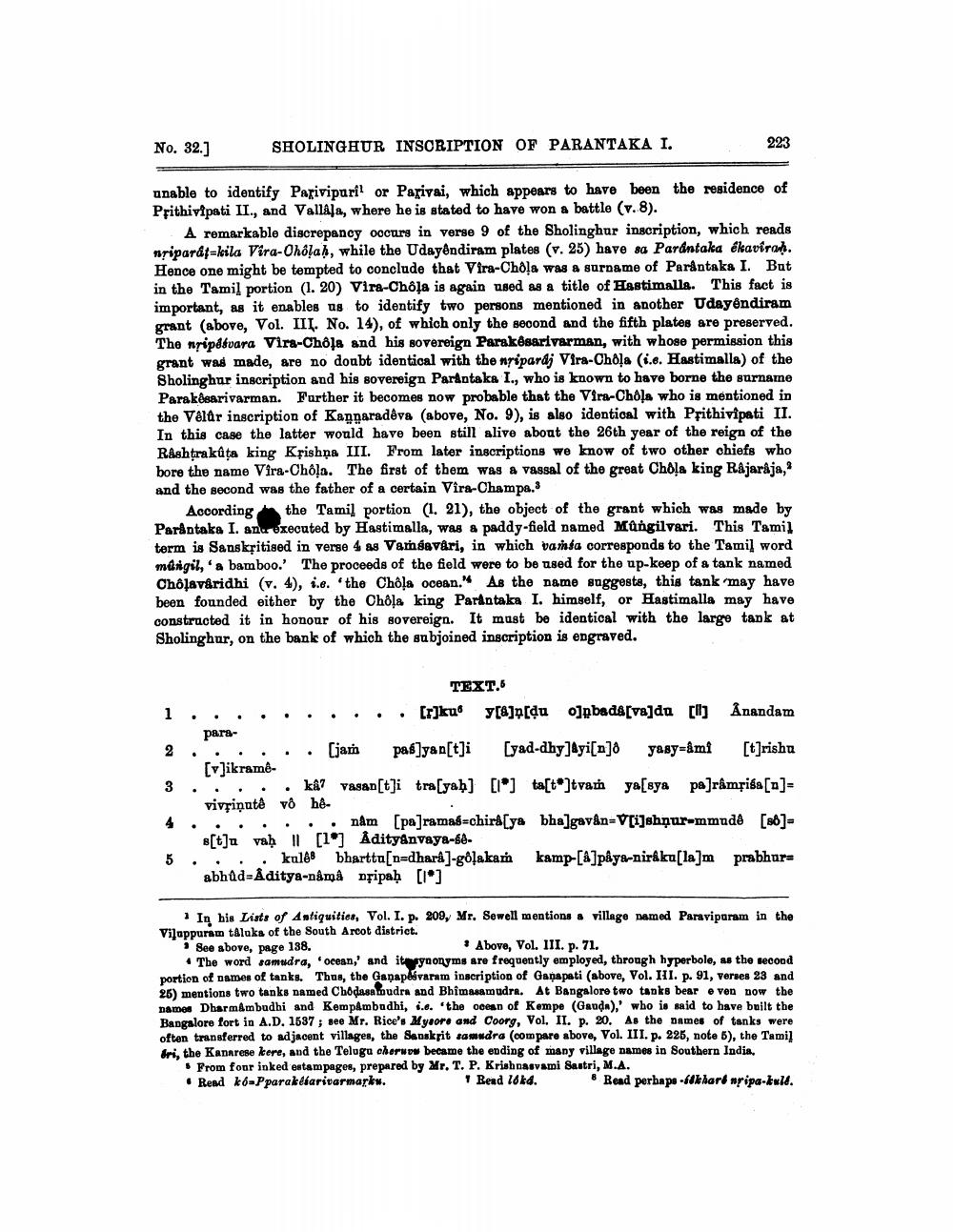________________
No. 32.]
SHOLINGHUR INSCRIPTION OF PARANTAKA I.
223
unable to identify Parivipuril or Parivai, which appears to have been the residence of Prithivipati II., and Vallala, where he is stated to have won a battlo (v. 8).
A remarkable discrepancy occurg in verse 9 of the Sholinghur inscription, which reads nripardf-kila Vira-Ohôļah, while the Udayêndiram plates (v. 25) have sa Parantaka ekavirah. Hence one might be tempted to conclude that Vira-Chôļa was a surname of Parantaka I. But in the Tamil portion (1. 20) Vira-Chola is again used as a title of Hastimalla. This fact is important, as it enables us to identify two persons mentioned in another Udayêndiram grant (above, Vol. IIL, No. 14), of which only the second and the fifth plates are preserved. The nrépátvara Vira-Chola and his sovereign Parakesarivarman, with whose permission this grant was made, are no doubt identical with the nriparaj Vira-Chola (i.6. Hastimalla) of the Sholinghur inscription and his sovereign Parántaka I., who is known to have borne the surname Parakesarivarman. Further it becomes now probable that the Vira-Chola who is mentioned in the Vêlûr inscription of Kapparadeva (above, No. 9), is also identical with Prithivipati II. In this case the latter would have been still alive about the 26th year of the reign of the Rashtrakūta king Krishna III. From later inscriptions we know of two other chiefs who bore the name Vira-Chola. The first of them was a vassal of the great Chðļa king Rajaraja, and the second was the father of a certain Vira-Champa.
According the Tamil portion (1. 21), the object of the grant which was made by Parantaka I. anu Uxecuted by Hastimella, was a paddy-field named Mungilvari. This Tamil term is Sanskritised in verse 4 as Vamsaväri, in which varsa corresponds to the Tamil word mdigil, a bamboo. The proceeds of the field were to be used for the up-keep of a tank named Ohõlaviridhi (v. 4), 1.e. the Chola ocean." As the name suggests, this tank may have been founded either by the Chola king Parantaka I. himself, or Hastimalla may have constructed it in honour of his sovereign. It must be identical with the large tank at Sholinghur, on the bank of which the subjoined inscription is engraved.
TEXT.6 1.......... [r]ku [&][du opbada[vajda (1) Ånandam
para...... [jam paß]yan[t]i [yad-dhy]Ayi[n]# yasy=&mi [t]risha
[v]ikrame... ..kA7 vasan[t]i tra(yah] [I] ta[t*]tvam ya[sya parâmpisa[n]= ivyinute vô hệ
... nám [pa]ramaś=chira[ya bha]gavån=V[i]shņur-mmudd [80]= 8[t]a vaḥ || [10] Adityanvaya-se5 . . : . kald8
:
bhartta[n=dhara]-go!akan kamp-[&]pâya-niråka[la]m prabhura abhad-Aditya-nåmå opipa []
In his Lists of Antiquities, Vol. I. p. 209, Mr. Sewell mentions a village named Paraviparam in the Viluppuram tAluks of the South Arcot district. • See above, page 138.
• Above, Vol. III. p. 71. • The word samudra, ocean,' and it yaonyms are frequently employed, through hyperbole, as the second portion of names of tanks. Thus, the Ganapéávaram inscription of Ganapati (above, Vol. III. p. 91, verses 23 and 26) mentions two tanks named Choqasamudra and Bhimasamudra. At Bangalore two tanks bear even now the namen Dharmambudhi and Kempambodhi, i.e. 'the ocean of Kempe (Gauda),' who is said to have built the Bangalore fort in A.D. 1687; see Mr. Rice's Mysore and Coorg, Vol. II. p. 20. As the names of tanks were often transferred to adjacent villages, the Sanskrit samudra (compare above, Vol. III. p. 225, note 6), the Tamil Iri, the Kanarese kere, and the Telugu chorwow became the ending of many village names in Southern India,
. From four inked estampages, prepared by Mr.T. P. Krishnasvami Sastri, M.A. • Read kó-Pparakliarivarmarku.
1 Read 16kd.
Read perhape -khari nripa-kult.




